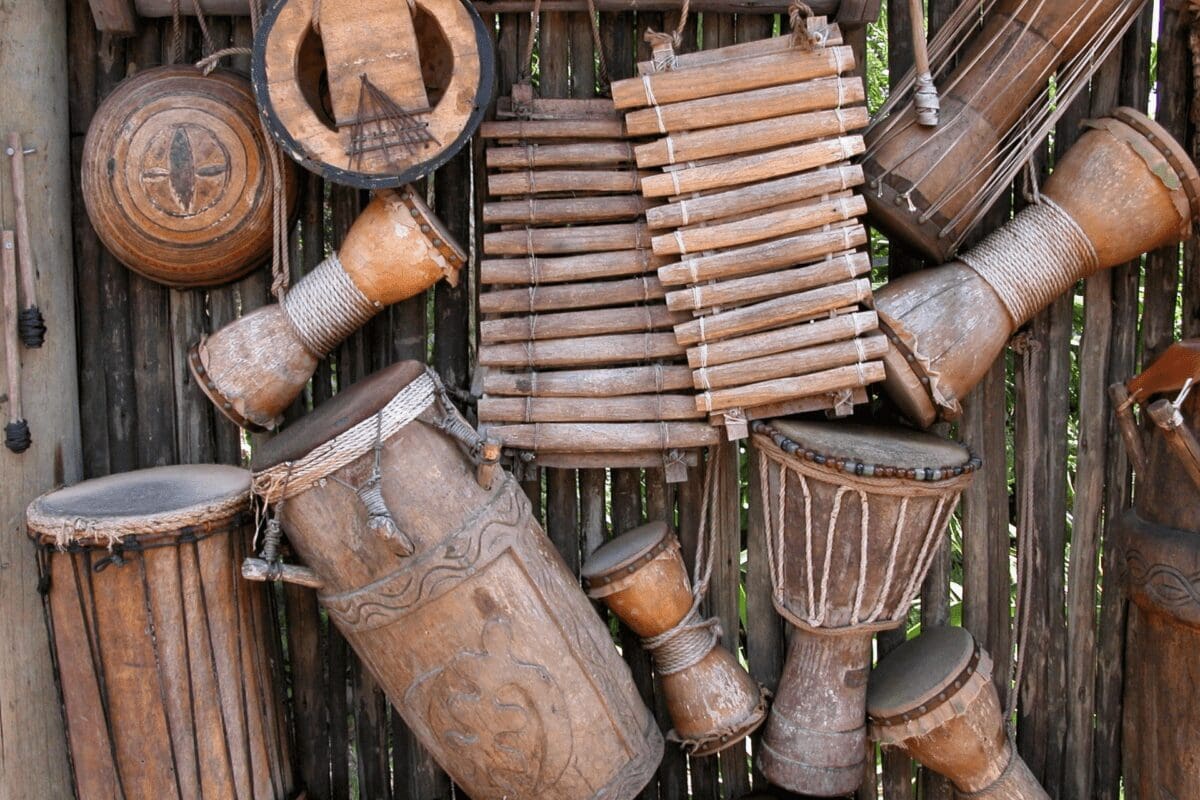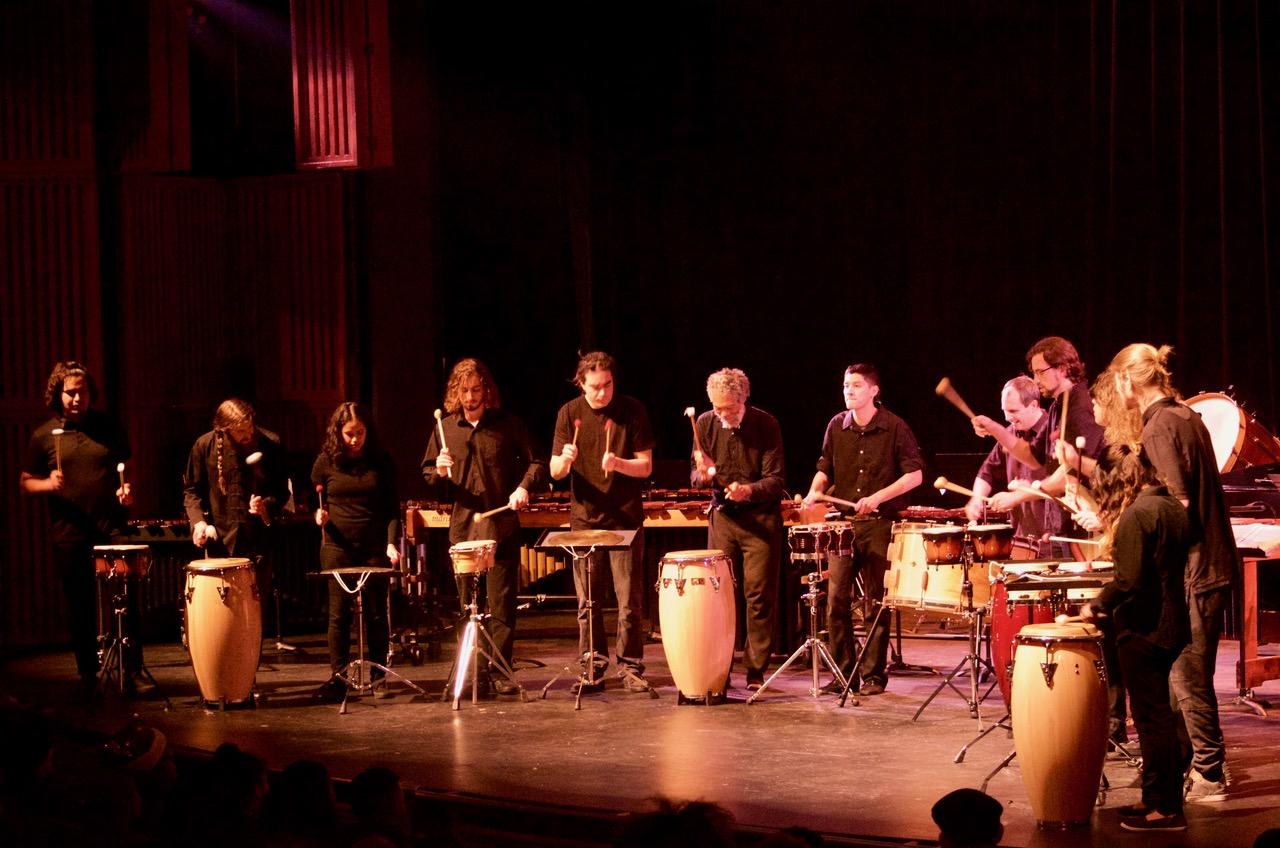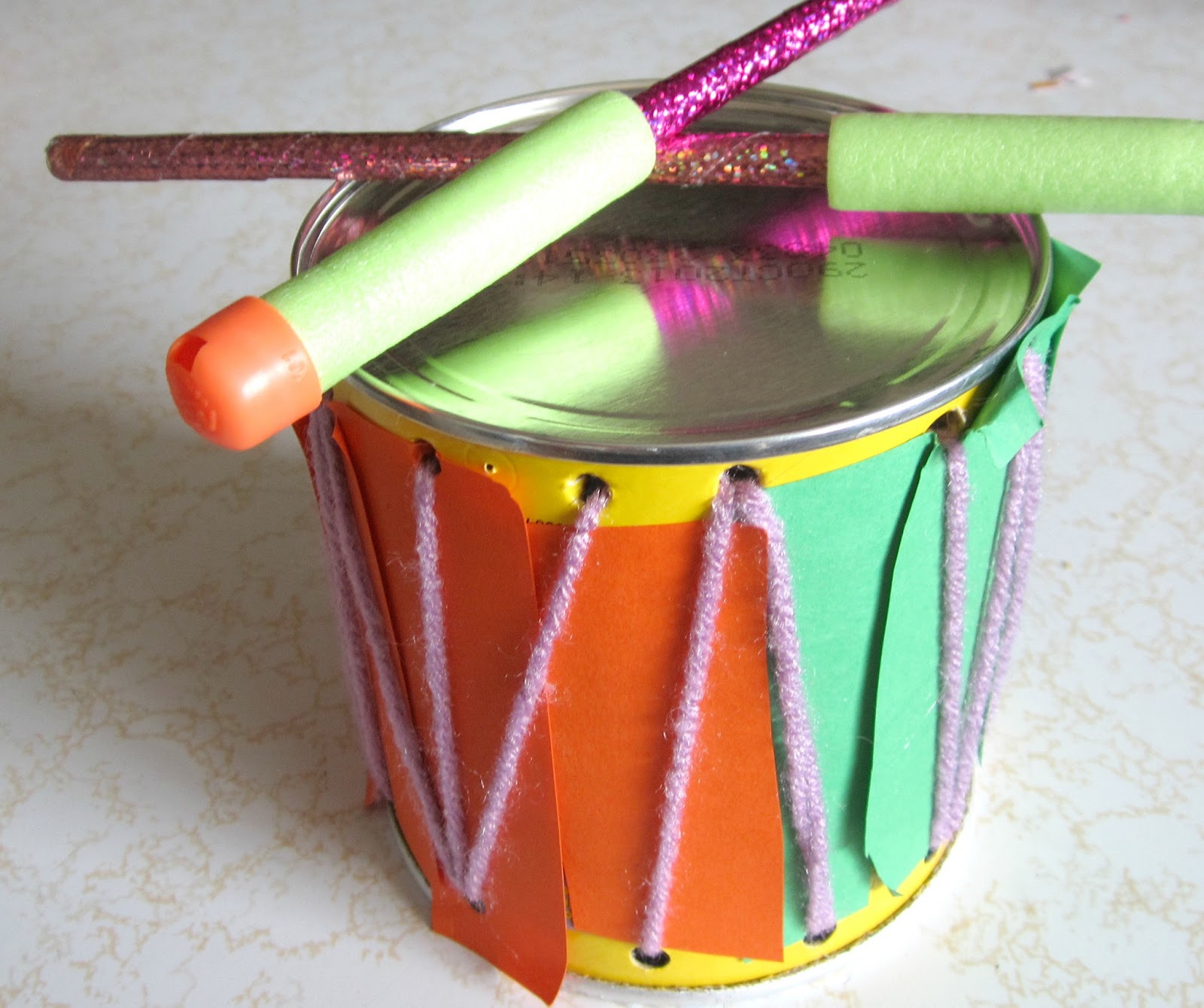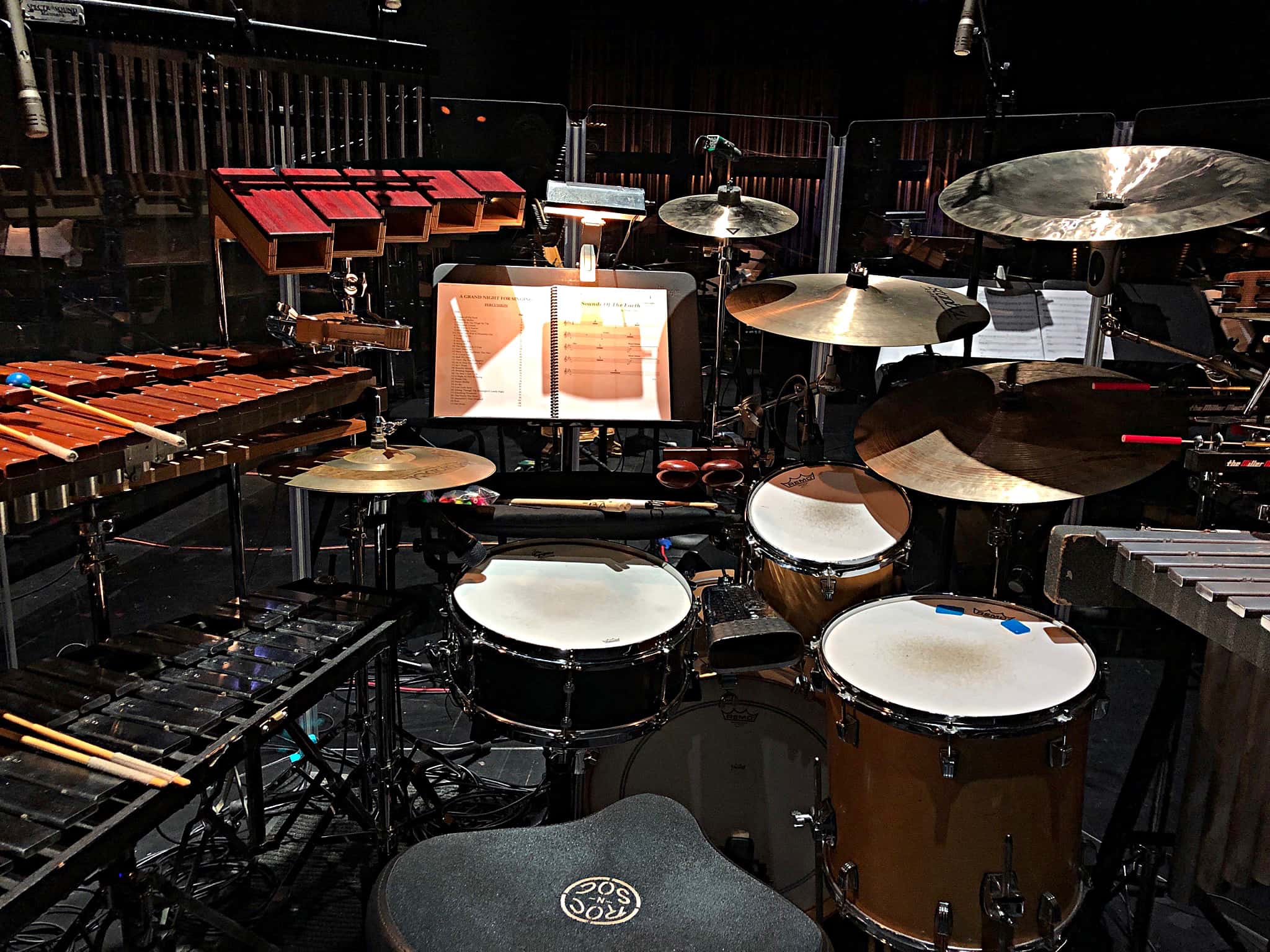Home>Instruments>Percussion Instruments>What Are Examples Of Percussion Instruments
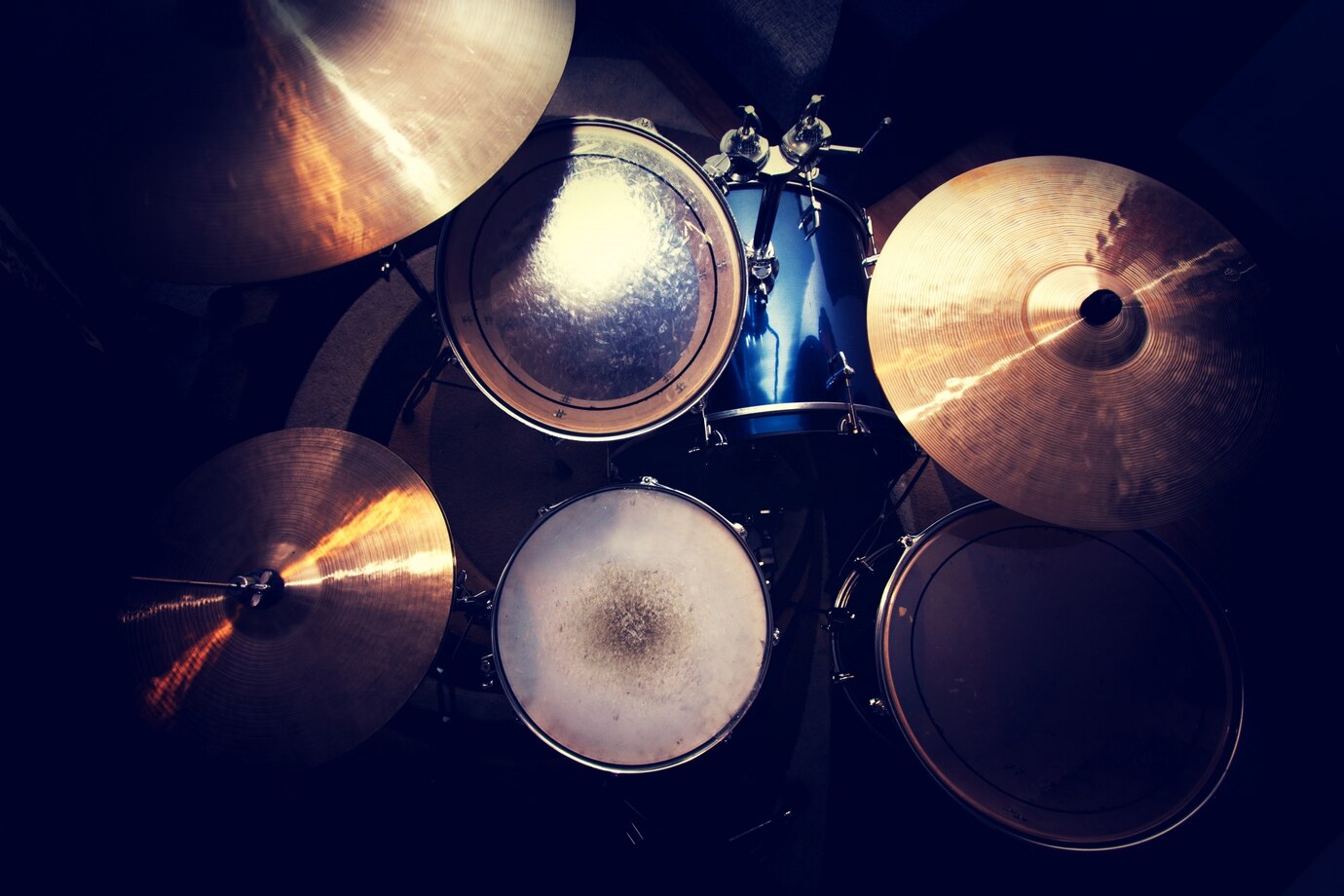

Percussion Instruments
What Are Examples Of Percussion Instruments
Published: January 16, 2024
Discover various examples of percussion instruments, including drums, cymbals, tambourines, and maracas. Explore the diverse sounds and rhythms produced by these versatile musical instruments.
(Many of the links in this article redirect to a specific reviewed product. Your purchase of these products through affiliate links helps to generate commission for AudioLover.com, at no extra cost. Learn more)
Table of Contents
Introduction
Percussion instruments have been an integral part of human culture since ancient times. They add rhythm, texture, and excitement to music, often serving as the backbone of any musical composition. From the thunderous beats of drums to the delicate sounds of tambourines, percussion instruments encompass a wide array of unique and diverse sounds.
What sets percussion instruments apart is the way they are played. Unlike string or wind instruments where pitch is produced by manipulating the length or tension of a vibrating element, percussion instruments produce sound through striking, shaking, or scraping. This allows for a vast range of tonal possibilities, making percussion instruments versatile and vital in different genres of music.
Throughout history, percussion instruments have been used in various cultural and musical traditions across the world. From tribal ceremonies to symphony orchestras, these instruments have evolved over time, reflecting the unique characteristics and musical flavors of different regions and societies.
Today, percussion instruments are widely used in various genres of music, including classical, rock, jazz, folk, and pop. They provide the rhythmic foundation and add depth and excitement to musical compositions. Additionally, percussion instruments are not confined to large ensembles or professional musicians; they can be enjoyed by anyone, from children experimenting with their first drum set to adults playing in community bands or jamming with friends.
In this article, we will explore different types of percussion instruments, from the thunderous beats of drums to the delicate sounds of tambourines. We will delve into their history, construction, and unique characteristics, providing examples of each instrument to showcase the diverse world of percussion.
Types of Percussion Instruments
Percussion instruments can be classified into various categories based on how they produce sound and their physical characteristics. Here are some examples of percussion instruments:
- Drums: Drums are perhaps the most well-known and widely recognized percussion instruments. They consist of a hollow shell, known as a drum head, stretched over one or both ends. The drum is played by striking the drumhead with hands, sticks, mallets, or brushes. Drums come in various sizes and shapes, including bass drums, snare drums, tom-toms, and djembe drums.
- Tambourines: Tambourines are circular instruments with a shallow frame and a series of metal jingles, known as zils, attached to the rim. When the tambourine is shaken or struck, the zils produce a bright and jingling sound. Tambourines are commonly used in folk music, as well as in genres like rock and pop.
- Maracas: Maracas are handheld percussion instruments originating from Latin American music. They consist of hollow gourds filled with dried seeds or beads. When shaken, they produce a shaking or rattling sound. Maracas are often used in Latin music, as well as in various genres where a rhythmic percussive effect is desired.
- Timpani: Also known as kettle drums, timpani are large, deep-bodied drums with a bowl-shaped top. They are tuned to specific pitches by adjusting the tension of the drumheads. Timpani are commonly used in orchestras and provide deep and resonant tones.
- Xylophones: Xylophones are melodic percussion instruments consisting of wooden bars of varying lengths suspended over resonators. When struck with mallets, they produce distinct and pitched tones. Xylophones are often used in schools and orchestras and are popular in genres like classical and African music.
- Cymbals: Cymbals are metallic percussion instruments characterized by their circular shape and vibrant sound. They are made of two concave plates of metal, either bronze or brass, that are struck together or individually to produce crashing or shimmering sounds. Cymbals are commonly used in orchestras, rock bands, and various world music traditions.
- Bongos: Bongos are a pair of small, open-bottomed drums joined together. They are played with hands and fingers, and produce a high-pitched, resonant sound. Bongos are commonly used in Latin music, jazz, and other genres that require complex rhythmic patterns.
- Congas: Congas are tall, narrow drums originating from Cuba. They come in different sizes and are made from wood or fiberglass. Congas are played with hands and fingers and produce deep, resonant tones. They are widely used in Afro-Cuban music, salsa, and other Latin genres.
- Djembe: The djembe is a goblet-shaped drum with a skin drumhead. Originating from West Africa, it is played with bare hands and produces a wide range of tones and timbres. The djembe is highly versatile and is often used in African, world, and contemporary music.
- Triangle: The triangle is a small, metallic percussion instrument in the shape of a triangle. It is played by striking it with a metal beater or a violin bow. Despite its simplicity, the triangle adds a delicate and shimmering sound to various genres of music, including classical, jazz, and pop.
These are just a few examples of the wide variety of percussion instruments available. Each instrument has its own unique sound and playing technique, offering endless possibilities for musicians and composers to explore rhythmic textures and create captivating musical arrangements.
Drums
Drums are one of the most versatile and widely recognized percussion instruments. They are commonly found in various musical styles and cultures around the world. The basic structure of a drum consists of a hollow shell, often made from wood or metal, with a drumhead stretched over one or both ends.
Drums can vary greatly in terms of size, shape, and playing techniques, resulting in a wide range of sounds. They can be classified into different categories, including bass drums, snare drums, tom-toms, and djembe drums, each with its own unique characteristics.
The bass drum, also known as the kick drum, is the largest drum in the drum set. It is played with a pedal attached to a mallet, which strikes the drumhead. The bass drum produces deep and booming sounds that provide the rhythmic foundation for many genres of music, including rock, jazz, and orchestral compositions.
The snare drum is perhaps the most iconic drum in the drum set. It has a set of wires, called snares, stretched across the bottom drumhead. When the top drumhead is struck with drumsticks, the snares vibrate against the bottom head, creating a distinct and snappy sound. The snare drum is known for its versatility and is used in various music genres, ranging from marching bands to pop and rock music.
The tom-toms are a set of drums with no snares. They come in different sizes and are often arranged in a row or vertically in a drum set. Each tom-tom produces a different pitch, allowing drummers to create melodic patterns and add depth to their grooves. Tom-toms are commonly used in rock, jazz, and fusion music.
The djembe is a hand drum originating from West Africa. It has a goblet-shaped body with a skin drumhead that is typically played with bare hands. Djembe drums produce a wide range of tones, from deep bass notes to high-pitched slaps. They are highly versatile and are widely used in African, world, and contemporary music.
Overall, drums are a fundamental component of percussive ensembles, bands, and orchestras. They provide rhythmic drive, dynamics, and groove to music, allowing drummers to showcase their creativity and musicality. Whether pounding out a thunderous beat or delicately adding subtle accents, drums play a vital role in creating engaging and energetic musical performances.
Tambourines
Tambourines are percussion instruments that are instantly recognizable by their circular shape and jingling sound. They consist of a shallow frame with a drumhead and jingles, known as zils, attached to the rim. When the tambourine is shaken or struck, the zils produce a bright and jingling sound that adds a lively and festive element to music.
Tambourines have a long history and are found in various cultures around the world. They are particularly prominent in folk music traditions, but they are also used in genres like rock, pop, and classical music.
The frame of a tambourine is typically made of wood, plastic, or metal, and is covered with a drumhead made of animal skin or synthetic material. The drumhead can be played by striking it with fingers or a drumstick, as well as by shaking the tambourine to create a continuous jingling sound.
Tambourines are versatile instruments, allowing for a range of playing techniques and sounds. By varying the intensity and speed of shaking or striking, musicians can create different rhythms, accents, and textures to suit the musical context.
In addition to the jingling sound produced by the zils, tambourines can also provide a percussive sound when the hand or stick strikes the drumhead. This adds a rhythmic punch and allows for dynamic rhythmic patterns to be played.
Tambourines are often used in folk dances, providing a rhythmic accompaniment for dancers and adding a celebratory element to the performance. They are also commonly found in marching bands, where their bright jingling sound can cut through the ensemble and provide a sense of energy and excitement.
In contemporary music, tambourines can be heard in a wide range of genres and styles. They are frequently used in pop and rock music to add a catchy and percussive element to the rhythm section. Additionally, tambourines are also used in orchestral music, primarily in pieces that require a folk or exotic sound.
Overall, tambourines are versatile and playful percussion instruments that add a vibrant and festive element to music. Whether used in traditional folk music, contemporary pop songs, or orchestral compositions, tambourines bring a sense of joy and liveliness to any musical performance.
Maracas
Maracas are handheld percussion instruments that are commonly associated with Latin American music. They consist of a pair of hollow gourds or wooden shells filled with dried seeds or beads. When shaken, the seeds or beads strike the walls of the maracas, creating a shaking or rattling sound.
Maracas have a long history and can be found in various forms across different cultures. They are believed to have originated from indigenous tribes in Latin America and were eventually adopted into the broader musical landscape of the region.
The shells of maracas are often decorated with colorful patterns and designs, making them visually appealing. The size and shape of maracas can vary, but they are generally shaped like an elongated pear or an hourglass.
To play the maracas, the player holds one in each hand and shakes them rhythmically. The intensity and speed of the shaking can be adjusted to create different rhythms and accents. The sound produced by maracas is crisp and percussive, adding a dynamic and rhythmic texture to the music.
Maracas are frequently used in various genres of Latin American music, such as salsa, merengue, and cumbia. They are an essential part of the rhythm section and provide a lively and infectious rhythm that is characteristic of these styles.
Besides Latin music, maracas have also made their way into other genres. They can be heard in jazz, pop, and even rock music, where they add a distinctive percussive element. Maracas are often used to create a sense of groove, providing a steady and infectious rhythm that enhances the overall sound of a song.
With their simple yet captivating sound, maracas are also popular among children and can be found in educational settings. They are often used as a first percussion instrument, allowing young learners to explore rhythm and musical expression.
Maracas are not only musical instruments but also cultural symbols. They represent the vibrant and celebratory spirit of Latin American music and have become iconic representations of the region’s rich musical traditions.
Whether used in traditional folk music, contemporary Latin genres, or children’s music, maracas bring a lively and rhythmic energy to any musical setting. Their distinctive sound and simple playing technique make them accessible to musicians of all levels and add a joyful and percussive element to the music.
Timpani
Timpani, also known as kettle drums, are large and deep-bodied percussion instruments that are widely used in orchestral music. They consist of a bowl-shaped copper or fiberglass shell and a drumhead, usually made of plastic or goatskin, stretched over the top.
Timpani are unique among percussion instruments as they can be tuned to specific pitches. This is achieved by adjusting the tension of the drumhead using a pedal mechanism or by manually tuning the drumhead with a tuning key. The ability to tune the timpani allows them to play specific musical notes and contribute to the overall harmony of an ensemble.
The sound of a timpani is rich and resonant, with a sustained tone. They are played by striking the drumhead with wooden sticks, known as timpani mallets. Depending on the desired volume and articulation, different parts of the drumhead can be hit, producing a range of tones and dynamics.
In an orchestral setting, timpani serve various roles. They provide the foundational pitch for the ensemble and help establish the key of a musical composition. Timpani are often used to accentuate important moments in the music, add dramatic effects, or create a sense of tension and excitement.
In addition to orchestral music, timpani can also be found in concert bands, marching bands, and other larger ensembles. They bring depth and richness to the overall sound, enhancing the rhythmic drive and adding a sense of grandeur to the performance.
The timpani player, also known as a timpanist, plays a crucial role in an ensemble. They must have a keen sense of rhythm, dynamics, and musicality. Timpanists must be skilled at executing precise and controlled strokes to create the desired tone and articulation.
Due to their size and weight, timpani are not easily portable and are typically found in concert halls or larger performance spaces. They require careful maintenance, including regular tuning and replacing the drumheads, to ensure optimal sound quality.
Overall, the timpani are revered for their majestic sound and important harmonic role in orchestral and ensemble performances. Their deep and resonant tones add depth, drama, and musical color to compositions, truly making them an indispensable part of the percussion family.
Xylophones
Xylophones are melodic percussion instruments that originate from ancient times and are still widely used in various musical traditions around the world. They consist of a series of wooden bars of varying lengths that are arranged in a specific order and suspended over resonators.
The bars of a xylophone are typically made of wood, although there are also xylophones with bars made of synthetic materials like fiberglass or metal. The bars are tuned to specific pitches, and when struck with mallets, they produce distinct and pitched tones.
One unique feature of the xylophone is its bright and percussive sound. The wooden bars, when struck, create a sharp and resonant tone that resonates through the resonators. This gives the xylophone its characteristic sound, which can range from delicate and ethereal to vibrant and energetic.
Xylophones are known for their versatility and are used in a variety of musical genres and cultures. They can be found in classical orchestras, where they add a melodic and harmonic element to the ensemble. Xylophones are also prominent in African and Indonesian music, where they are used in traditional and cultural performances.
In schools, xylophones are often utilized as an educational tool to teach children about melody, rhythm, and music theory. They are relatively easy to learn and allow students to develop their coordination and musical skills.
Playing the xylophone requires the use of mallets, which can either be made of wood, rubber, or other materials. The player strikes the bars with the mallets to produce the desired pitches and tones. By varying the technique and force of the strikes, a skilled xylophonist can create expressive and nuanced melodies.
One notable variation of the xylophone is the marimba, which has resonators beneath the bars to enhance the instrument’s volume and resonance. The marimba is larger and has a lower range compared to the traditional xylophone, giving it a deeper and warmer sound.
With their bright and melodic tones, xylophones add a unique character to musical compositions. They are often used to create memorable melodies, provide counter melodies, or add colorful textures to an arrangement. Xylophones bring a sense of playfulness, vibrancy, and musicality to any piece of music.
Overall, xylophones are loved for their distinctive sound and versatility. From classical compositions to world music and educational settings, these melodic percussion instruments continue to captivate audiences and inspire musicians with their enchanting tones.
Cymbals
Cymbals are metallic percussion instruments characterized by their circular shape and vibrant sound. They have been used for centuries in various musical traditions around the world. Cymbals are made of two concave plates of metal, usually bronze or brass, that are struck together or individually to produce crashing or shimmering sounds.
One of the distinguishing features of cymbals is their versatility. They can be played in a variety of ways, each producing a distinct sound. When struck with a drumstick or mallet, cymbals create a sharp and metallic sound. Depending on the force and technique used, the sound can range from a subtle shimmer to a loud, crashing roar.
Cymbals are widely used in different musical genres and ensembles. In orchestral settings, they are commonly found in symphony orchestras, where they punctuate important moments in a composition and add dramatic and climactic effects. Cymbals can also be heard in marching bands, concert bands, and jazz ensembles, where they provide accents and contribute to the overall rhythmic texture.
One specific type of cymbal is the ride cymbal. It is larger in size and has a more sustained sound compared to other types. Ride cymbals are often used in jazz music, where they are played with drumsticks or brushes to create rhythmic patterns and provide a steady ride cymbal rhythm.
Another popular use of cymbals is in rock and pop music. Crash cymbals, with their explosive and vibrant sound, are often used to accentuate powerful moments or to mark transitions in a song. They add energy, excitement, and a dynamic edge to the music.
Besides being struck, cymbals can also be clashed together, producing a distinctive sound known as a cymbal choke. This technique involves hitting one cymbal and immediately pressing the other against it to stop the vibrations, resulting in a short and dramatic sound effect. The cymbal choke is often used to create punchy and abrupt accents in various styles of music.
With their wide range of sounds and expressive possibilities, cymbals are beloved by percussionists and composers alike. They provide a vibrant and shimmering quality to musical compositions, offering a dramatic and captivating presence that enriches the overall sonic experience.
Playing cymbals requires precision and control. A skilled cymbalist must have a keen sense of timing, dynamics, and musicality to use cymbals effectively in performance. Mastering the art of playing cymbals involves understanding the different techniques and nuances to produce a desired sound.
Overall, cymbals are essential components of the percussion family, adding brilliance, power, and a touch of magic to musical compositions. Their rich and expressive qualities make them a dynamic and important part of various genres of music, from orchestral masterpieces to the driving rhythms of rock and pop.
Bongos
Bongos are a pair of small, open-bottomed drums joined together by a bridge. They are an iconic percussion instrument that originated in Afro-Cuban music but have gained popularity worldwide. Bongos consist of two drums of different sizes: the larger drum is called the hembra (female), and the smaller drum is known as the macho (male).
Traditionally, bongos have wooden shells with drumheads made of animal skin. However, modern bongos also feature synthetic drumheads for increased durability and consistency in sound. The drumheads are tightened using metal hardware such as tuning lugs and tension rods.
Bongos are played by striking the drumheads with the hands and fingers. The player can create a variety of sounds by hitting different parts of the drumheads or using different hand techniques. The hembra drum generally produces a lower pitch, while the macho drum produces a higher pitch.
Bongos are known for their distinctive, resonant sound. They have a crisp and melodic tone that cuts through the music and adds an infectious rhythm. The rhythmic patterns played on the bongos can be intricate and complex, making them an integral part of Latin music genres such as salsa, rumba, and son.
In addition to Latin music, bongos are also used in jazz, fusion, and world music. They are favored by percussionists for their versatility and ability to add an energetic and lively rhythmic element to a wide range of musical styles.
Bongos are relatively compact and portable, making them accessible for musicians of all levels. They are commonly used in small ensembles, jam sessions, and street performances. Bongos are also popular among beginners and are often used in music education programs and drum circles.
Learning to play the bongos requires a good sense of rhythm and hand coordination. Understanding different hand techniques such as open tones, slaps, and muted tones allows for a wide range of expressive possibilities on the instrument.
Overall, bongos are cherished for their vibrant and infectious sound. Their rhythmic capabilities and versatility make them an essential element in various genres of music, providing a dynamic and captivating presence that elevates the overall musical experience.
Congas
Congas are tall, narrow drums that have their roots in Afro-Cuban music. They are an iconic percussion instrument known for their deep and resonant tones. Congas typically come in sets of two or three drums, though larger ensembles may have additional drums. Each drum produces a distinct pitch, allowing for melodic patterns and rich harmonic possibilities.
The drums are traditionally made from wooden shells, such as mahogany or oak, with drumheads made from animal skin like cowhide or goat skin. Modern congas also feature synthetic drumheads that offer consistency and durability. The drumheads are secured with metal hoops and tuning lugs, allowing for precise tuning and adjustments.
Congas are played with the hands and fingers, striking the drumheads to produce a variety of tones and sounds. Different areas of the drumheads can be used to create distinct sounds, such as open tones, slaps, and muted tones. Skilled conga players can create complex rhythms with a combination of techniques, adding depth and flair to the music.
Congas are a vital element in Latin music genres, including salsa, rumba, and Afro-Cuban jazz. They provide the rhythmic foundation and drive in the ensemble, adding a pulsating groove that encourages dance and movement. Congas are often played in a seated position, using a combination of palms, fingertips, and heel-toe techniques to bring out the intricate rhythms.
One notable aspect of conga playing is the concept of “tumbao,” which refers to a repetitive and syncopated rhythmic pattern typically played on the lowest-pitched drum. Tumbao patterns are essential to the rhythm section and serve as the backbone of many Latin music compositions.
Congas have also gained popularity in genres outside of Latin music, including jazz, fusion, and world music. They are prized for their versatility, as they can add depth and texture to a variety of musical styles. Congas have found their way into contemporary pop and rock music as well, adding an exotic touch to the rhythm section.
Learning to play the congas requires dedication, as it involves rhythmic precision and control. Developing a strong sense of timing and being able to effectively navigate different patterns is essential for conga players.
Overall, congas are cherished for their rich and powerful sound. They bring excitement, energy, and a rhythmic vitality to music, making them an integral part of Latin and world percussion traditions.
Djembe
The djembe is a versatile and captivating hand drum that originated from West Africa. It is widely recognized for its distinct goblet-shaped body and its ability to produce a wide range of tones and timbres. Djembe drums have gained popularity around the world and are now commonly used in various genres of music.
Traditionally, djembes are carved from a single piece of hardwood and have a drumhead made of goat skin or synthetic material. The drumhead is attached to the body using a tension system, often consisting of ropes or metal rings. The tension of the ropes can be adjusted to control the pitch and resonance of the drum.
The djembe is played with bare hands, using techniques that involve striking the drumhead with the fingertips, palm, or edge of the hand. Various hand positions and striking techniques create different sounds, allowing for a wide range of expressive possibilities. The djembe can produce deep, resonant bass tones, ringing slaps, and vibrant tones in between.
One unique aspect of the djembe is its ability to mimic the human voice. Skilled djembe players can create a wide range of sounds, including pitches, accents, and dynamics that resemble speech patterns. This makes the drum highly expressive and allows players to communicate and tell stories through their drumming.
The djembe holds great cultural significance in West African societies. It has traditionally been used in ceremonies, rituals, and celebrations, serving as a way to bring communities together and express cultural identity. The drum is often accompanied by dancers and other instruments such as dunun drums and shekere.
The djembe has gained popularity in various music genres outside of West Africa as well. It is commonly heard in world music, fusion, and contemporary genres. The drum’s versatility, rhythmic capabilities, and unique sound make it an attractive instrument for musicians seeking to incorporate global percussion elements into their compositions.
Learning to play the djembe requires a combination of technique, rhythm, and musicality. Djembe players develop a sense of timing, control, and coordination to create dynamic rhythms and nuanced playing. The drum’s hand-played nature allows for personal expression and improvisation, making each performance unique.
Overall, the djembe is cherished for its vibrant and infectious sound. It has become a symbol of African culture and a bridge between different musical traditions. Whether played in traditional West African settings or in global music collaborations, the djembe brings a rhythmic energy and vibrant spirit to any musical performance.
Triangle
The triangle may be one of the simplest percussion instruments in terms of design, but its impact on music is undeniable. Often found in orchestras and various musical ensembles, the triangle provides a distinctive and shimmering sound that adds a touch of brilliance to compositions.
A triangle consists of a small steel rod bent into a triangular shape, with one corner left open. The musician holds the triangle by its center and strikes it with a metal beater or a violin bow. The resulting sound is characterized by a high-pitched, ringing tone that cuts through the surrounding instruments.
Despite its seemingly straightforward nature, playing the triangle requires skill and precision. The musician must strike the triangle at the right angle and with the appropriate amount of force to produce a clear and resonant sound. Additionally, the placement of the instrument and the acoustics of the performance space play a role in shaping the overall sound.
The triangle’s role in music varies depending on the composition. It can serve as a rhythmic accent, punctuating important moments in a piece, or as a melodic instrument, playing simple and repetitive sequences. The sustained vibrations of the triangle create a lingering effect that adds depth and texture to the music.
The triangle is commonly found in classical orchestral music, where it is often paired with other percussion instruments to create a rich and layered sound. It is also utilized in genres such as jazz, pop, and even rock, where it may be used sparingly but effectively to add a sparkling touch to specific sections of a song.
As a percussion instrument, the triangle is often associated with precision and attention to detail. Playing the triangle requires a keen sense of timing, dynamics, and musicality. The musician must be able to seamlessly integrate their playing with the overall ensemble, adding the right amount of sparkle without overpowering other instruments.
Although the triangle may seem like a modest instrument, its role in music cannot be underestimated. It brings a touch of magic and brilliance to compositions, contributing to the overall texture and dynamics of the music. The simplicity of the instrument belies its ability to captivate and enhance a wide range of musical genres.
With its unmistakable sound and delicate presence, the triangle remains a cherished member of the percussion family. From symphony halls to studio recordings, the triangle continues to leave its mark on music, proving that even the simplest of instruments can make a significant impact.
Conclusion
Percussion instruments play a vital role in the world of music. From the thunderous beats of drums to the delicate sounds of tambourines, percussion instruments add rhythm, texture, and excitement to compositions across various genres.
Throughout history, percussion instruments have evolved and adapted, reflecting the diverse cultures and musical traditions of different regions. They have been used in ceremonial rituals, folk music, orchestral masterpieces, and popular songs, showcasing their versatility and universality.
Each percussion instrument has its own unique characteristics, construction, and playing techniques. Drums provide the rhythmic foundation, tambourines add a vibrant jingling sound, maracas bring a festive touch, and timpani offer deep and resonant tones. Xylophones provide melodic qualities, cymbals add brilliance, bongos bring a lively rhythmic element, and congas offer rich harmonies. The djembe captivates with its expressive sound, while the triangle adds a touch of brilliance and sparkle.
While percussion instruments differ in their physical attributes and sounds, they all share the ability to enhance musical compositions and captivate listeners. They provide the driving force, texture, and dynamics that make music come alive.
Whether you’re playing percussion instruments professionally or as a hobbyist, the world of percussion offers endless possibilities for exploration and creativity. Each instrument offers unique sonic possibilities, allowing for individual expression and creating a profound impact on the overall sound of a performance.
From the tribal rhythms of ancient cultures to the contemporary beats of modern music, percussion instruments continue to shape and enrich the world of music. They bring energy, rhythm, and emotion to compositions, elevating the listening experience and allowing audiences to connect with the music on a deeper level.
As we continue to appreciate and celebrate the diverse world of percussion, may we recognize the profound role that percussion instruments play in our lives. Through their unique sounds, they inspire us, move us, and create a rhythmic tapestry that transcends language and cultural barriers.
So, the next time you listen to a song or attend a live performance, take a moment to appreciate the percussion instruments that add that extra layer of rhythm and excitement, bringing music to life in a way that only percussion can do.







